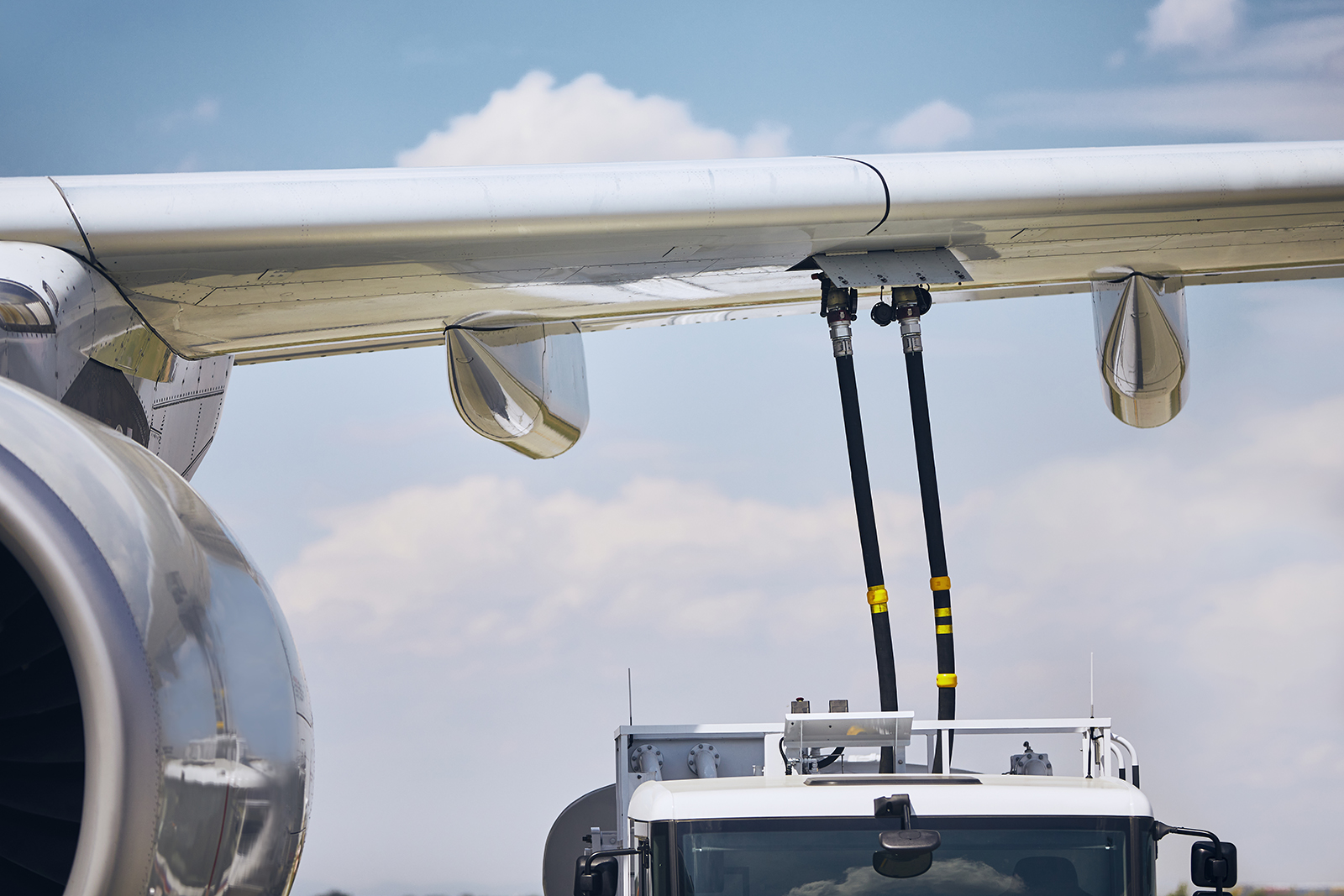Sustainable Aviation Fuel: A Catch-22 Making Emissions Cuts Tough

A gallon of sustainable aviation fuel emits up to 80% less carbon dioxide than conventional jet fuel (pictured).
Photo: Jaromir Chalabala/EyeEm via Getty Images
Sustainable aviation fuel (SAF) — a biofuel similar in chemistry to conventional jet fuel but with significantly fewer carbon emissions — is probably the most important, and definitely the most immediate, tool airlines can use in their quest for net zero. Yet by 2030, despite dozens of new production facilities and billions of dollars invested in SAF production, there simply won’t be enough to stop the rise in global aviation emissions — let alone reduce it.
To limit emissions from air travel to 2019 levels, about 15% of the jet fuel consumed in 2030 would have to be SAF. That’s equivalent to a supply of about 16 billion gallons, based on Oliver Wyman’s projections for growth in both the global commercial aircraft fleet and demand for travel. But the best-case scenario for SAF supply in 2030 is for only about 5.4 billion gallons to be produced. That would represent only about 5% of jet fuel consumption globally, which in turn is likely to translate into a rise in airline emissions, given the steady growth in air travel worldwide. The more likely scenario is for a production of only about 3.1 billion gallons, which of course would mean an even bigger rise in emissions.
SAF faces a vexing Catch-22: Production won’t expand sufficiently without binding commitments from airlines, and carriers will be unlikely to provide the commitments without guarantees of adequate supply.
Many airlines have come to understand the pivotal role SAF has to play moving forward and are encouraging SAF production with pledges of 10% usage by 2030. Those commitments, while not binding, exceed the proposed blending targets called for by the European Commission and IATA. But SAF producers still worry that airlines will not follow through because the aviation biofuel runs two to three times the price of conventional jet fuel.
Swing Capacity
The key to reaching at least the best-case scenario for SAF is figuring out how to get swing biofuel capacity — the 20% or so of production capable of turning out either renewable diesel (RD) or SAF — to switch to SAF. That’s not easy given the maturity of the renewable diesel marketplace, where there are large-scale players and both governmental mandates requiring usage and incentives that support the significantly larger market for the fuel. RD is used primarily in commercial road transport and heavy agricultural and construction equipment.
SAF has had the same incentive of a $1 blender’s tax credit per gallon as RD, but no mandated use in the United States or Europe. In 2025, the European Commission is mandating that airlines mix 2% SAF or some other low-carbon fuel with conventional jet fuel, which is well below what would be needed. That percentage will eventually rise to 85% but not until 2050.
As a result, the SAF market has remained small and opaque, discouraging airlines to turn to biofuel. In the recently enacted U.S. Inflation Reduction Act, SAF’s tax credit was bumped up significantly by 25 to 75 cents more per gallon. This is expected to help the situation, but there’s still no guaranteed market as there is with renewable diesel.
SAF also competes with renewable diesel for feedstock. Most biofuels, including SAF and RD, currently rely on hydroprocessed esters and fatty acids (HEFA) from used cooking oils, animal fats and other bio waste. But there are emerging alternatives that might ultimately bring down the cost of producing biofuels. Among the most promising are municipal solid waste and woody biomass byproducts, which are turned into SAF via gasification. At this point, the technology is both low yield and expensive to build. But these feedstocks are plentiful and less expensive than HEFA and could also prove critical to driving long-term scale in SAF.
The Importance of SAF
Why is SAF so pivotal in the decarbonization of aviation? First, the engineering and operational advances the industry depend on don’t produce the annual fuel efficiency gains they once did. Today, they reduce fuel consumption 1% to 2% annually — not nearly enough to offset rising emissions from expanding air travel.
Additionally, aircraft powered by low-carbon technologies, such as batteries, hydrogen fuel cells, or hydrogen fuel, are unlikely to be manufactured in volume before the second half of the 2030s. Then, it will take several decades for the tens of thousands of fossil fuel-propelled aircraft in the fleet to be replaced with low-carbon technology alternatives. At least through 2050 and probably longer, the industry will need to reduce emissions by using SAF, a gallon of which emits up to 80% less carbon dioxide than conventional jet fuel.
Ultimately, if we want to decarbonize aviation, the economics of SAF will have to be worked through. With the right government support and collaboration among energy companies, airlines and aerospace manufacturers, the next decade could see SAF play a consequential, even historic role in reducing aviation emissions. But SAF faces a vexing Catch-22: Production won’t expand sufficiently without binding commitments from airlines, and carriers will be unlikely to provide the commitments without guarantees of adequate supply.








